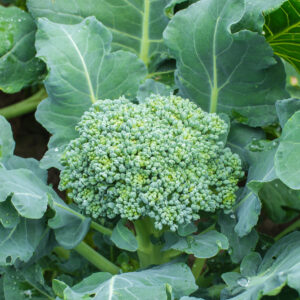
This article provides a comprehensive guide on growing broccoli. From the selection of variety, planting, and care, to harvesting and storage, each step is discussed in detail to guide you in how to grow broccoli at home. The practice of growing your broccoli can be rewarding, serving as a source of nutritious food and a fulfilling endeavor.
History
Broccoli, scientifically classified as Brassica oleracea var. italica, is a vibrant green vegetable with its roots in ancient Italy, dating back to the 6th Century BC. Belonging to the cabbage family, it bears a close kinship to cauliflower. The name “broccoli” finds its origins in the Italian term “broccolo,” which eloquently translates to “cabbage sprout.”
Nutritional value
Broccoli is renowned for its exceptional nutritional value, packed with vitamins A, C, and K, fiber, and multiple minerals. Its health benefits are plentiful, including boosting immune functionality, reducing inflammation, and improving digestive health.
In the culinary world, broccoli is highly versatile. It can be consumed raw, stir-fried, steamed, or even roasted. Its unique flavor and texture make it a popular ingredient in a variety of dishes worldwide, from salads and soups to stir-fries and casseroles.
Preparing the Soil
Importance of Soil Preparation, Ideal Soil Type, and pH
Soil preparation is a crucial step in successfully growing broccoli. A well-prepared soil forms the foundation of a healthy plant, promoting optimal root growth and nutrient uptake.
The ideal soil for growing broccoli is well-draining, loamy or sandy soil with high fertility. This type of soil has an excellent balance of clay, silt, and sand, which optimizes moisture levels and allows the roots to spread out and establish themselves. It’s also rich in organic matter, providing the nutrients broccoli needs to thrive.
The pH of the soil is another critical factor to consider. Broccoli thrives in soil with a slightly acidic pH range of 6.0 to 7.0. This optimal pH level ensures abundant nutrient availability and fosters robust plant growth.
Broccoli, being a nutrient-dense vegetable, requires soil rich in essential nutrients. Key nutrients for broccoli include nitrogen, phosphorus, and potassium. Nitrogen promotes vibrant and healthy leaf growth, phosphorus is vital for robust root development and blooming, while potassium enhances overall plant health and disease resistance. A well-balanced, slow-release fertilizer can help meet these nutrient needs. 5-10-10 is recommended.
Choosing Broccoli Cultivars based on Planting Zones
Different broccoli cultivars have varying degrees of resilience to weather and temperature fluctuations, making some better suited for certain planting zones than others.
For cooler climates, such as in USDA planting zones 2 to 5, the cultivar ‘Calabrese’ is a popular choice. This Italian variety is noted for its cold-hardiness and produces large, blue-green heads that are rich in flavor.
In warmer climates, USDA zones 6 to 8, ‘Green Magic’ is a preferred cultivar. Known for its heat tolerance and resistance to bolting, it yields well-formed, medium-sized heads with a sweet, slightly earthy taste.
In the hottest climates, zones 9 and above, ‘Imperial’ broccoli is often the best choice. This cultivar is heat-tolerant and produces a high yield of tight, dark green heads even under stressful conditions.
Remember, the best cultivar for your region will depend on specific local conditions including temperature ranges, the length of the growing season, and soil type. Always consult with a local extension service or experienced gardener for personalized advice.
Sowing the Seeds
Best Time of Year to Plant Broccoli Seeds
Broccoli is a cool-season crop that thrives in moderate to cooler weather conditions. The best time to plant broccoli seeds varies depending on your climate, but generally, seeds should be sown indoors 6-8 weeks before the last spring frost or directly outdoors 2-3 weeks before the last spring frost. For a fall harvest, sow the seeds directly outside 85-100 days before your area’s first expected fall frost.
Sowing Depth and Proper Spacing
When sowing broccoli seeds, the depth at which you plant them is crucial. Typically, broccoli seeds should be planted about 1/4 to 1/2 inch deep in the soil. Proper spacing is equally important for optimal growth. Individual plants should be spaced approximately 18 inches apart in rows that are about 24-36 inches apart. This spacing allows for adequate airflow, reducing the risk of disease, and gives each plant enough room to grow and spread out.
Caring for Broccoli Plants
Once the seeds are planted, broccoli plants need to be watered regularly. The soil should remain moist, but not overly saturated. Depending on the amount of rainfall in your area, you may need to water twice a week during dry spells. Try not to get the heads wet. It’s best to water the root area. Additionally, it is important to check the soil’s pH levels throughout the season and adjust
Identifying and Managing Common Pests and Diseases
Broccoli plants can be affected by a variety of pests and diseases. Pests such as cabbage worms, aphids, and flea beetles are common and can cause considerable damage.
Cabbage worms are easily identifiable as small green caterpillars on the leaves. These pests can be managed by handpicking or using a biological pesticide like Bacillus thuringiensis. Aphids are tiny insects that cluster underneath the broccoli leaves, sucking the plant’s sap and causing the leaves to turn yellow and curl. A strong spray of water or application of insecticidal soap can control their population.
Flea beetles create small holes on the leaves and can be managed by applying a natural or chemical-based insecticide.
Diseases prevalent among broccoli plants include blackleg and clubroot. Blackleg manifests as dark spots on stems and leaves, and it can be controlled by practicing good sanitation and crop rotation. Clubroot causes swollen, distorted roots and wilting of the plant. The best way to manage clubroot is by maintaining the soil’s pH at neutral to slightly alkaline levels.
Remember, a healthy plant is the best defense against pests and diseases. Providing your broccoli plants with the right nutrients, water, and care will make them more resilient and less prone to pests and diseases.
The Importance of Regular Weeding
Regular weeding plays a vital role in maintaining the health and productivity of your broccoli plants. Weeds compete with your plants for essential resources like water, sunlight, and nutrients. They can also harbor pests and diseases, which may potentially spread to your broccoli. By regularly removing weeds, you can ensure optimal growth conditions and reduce the risk of infestation or disease. Moreover, a clean, weed-free garden enhances the overall appearance of your vegetable patch. Remember to weed your garden gently to avoid disturbing the roots of your broccoli plants.
Harvesting and Storing
Broccoli is typically ready to harvest 70 to 100 days after planting, depending on the variety. The key indicator that your broccoli is ready for harvesting is the size and color of the head. The head should be firm and tight, with a deep green color. The individual florets should be closed. If they start to separate and show yellow petals (the beginning stages of flowering), you should harvest immediately, as the quality will deteriorate quickly from this point. To harvest, cut the central head and the stem at a slant, approximately 5 to 6 inches below the head. This will encourage the growth of side shoots, which will provide a secondary harvest.
After harvesting the main head of the broccoli, use a sharp, clean knife or shears to cut the stalk at an angle. This slant cut helps to prevent water from settling on the cut surface, preventing rot. When cutting, be sure to leave a generous amount of stalk to encourage the growth of side shoots for a secondary harvest.
While gathering the harvested broccoli, handle them carefully to avoid bruising or damaging the heads. Place them gently in a basket or container, and do not stack them too high to prevent crushing. Immediately after harvest, it’s best to take the broccoli indoors and prepare them for storage to maintain their freshness and nutritional value.
Storing and Preserving Fresh Broccoli
Broccoli is best when consumed fresh, but with proper storage methods, you can extend its shelf life without losing much of its nutritional value.
- Refrigerating: Broccoli can be stored in the refrigerator for up to a week. It’s best to store it unwashed in a loosely sealed plastic bag in the vegetable crisper drawer. Avoid washing broccoli before storage, as moisture can encourage mold growth.
- Freezing: For longer storage, broccoli can be blanched and frozen. Blanching (briefly boiling then immediately cooling in ice water) helps to preserve the color, texture, and nutritional value of broccoli during freezing. After blanching, pat the broccoli dry, and freeze it in an airtight container or freezer bag.
- Canning and Pickling: Canning and pickling are other preservation methods, although they might alter the taste and texture of the broccoli. These methods involve storing broccoli in a vinegar-based solution or in a sealed container that’s been boiled to create a vacuum seal.
Regardless of the storage method chosen, always choose the freshest broccoli for storage, as it will better retain its nutritional value and flavor.
Conclusion
To recap, growing broccoli successfully involves a few essential steps. You need to start by selecting a suitable variety of broccoli based on your local climate conditions and planting it in the right season. Providing broccoli with an environment rich in organic matter and ensuring it is well-drained is critical. Regular watering and fertilization are key to the growth of healthy broccoli plants, but be careful to avoid overwatering which can lead to diseases. When it comes to harvesting, it should be done timely before the buds open, cutting the stalk at a slant to prevent water damage. Lastly, proper storage methods can extend the shelf life of harvested broccoli, allowing you to enjoy its nutritional benefits for a longer period. Whether you choose refrigeration, freezing, or canning, keeping the broccoli as fresh as possible before storage will ensure it retains maximum flavor and nutritional value.
Growing your broccoli can be a rewarding experience, providing not only a source of healthy and nutritious food but also a sense of accomplishment. It gives you control over the quality of the food you consume, and it’s a great way to connect with nature. Don’t let the process intimidate you. As with any new endeavor, there may be challenges, but the joy of harvesting your broccoli is worth the effort. So, why not give it a try? You might discover a new passion for gardening along the way!
If broccoli is not your vegetable of choice check out my article on how to grow asparagus.
For more about gardening vegetables and herbs check here
For more about general gardening check here.
For more on homesteading and growing your own food check here.
Resource: https://www.almanac.com/plant/broccoli

